Disclosure: As an Amazon Associate I earn from qualifying purchases.
Choosing a thermal monocular can be confusing. With so many brands claiming to be the best, how can you know which one will actually perform when you’re out in the field? We wondered the same thing.
That’s why we took the most popular models and put them to the test where it matters—not in a lab, but in the real world. This guide is the result of that journey. We’ve broken down the complex specs into plain english and matched each monocular’s strengths to different needs, whether you’re a serious hunter, a property owner, or just getting started. Let’s cut through the hype and find the right thermal vision for you.
A Quick Look at Top 7 Thermal Monoculars
Image | Product | Key Strength | Rating | Price |
1 | Laser Rangefinder, Super Sharp Image | 9.5/10 | ||
2 | Amazing Value, Great Battery Life | 9.0/10 | ||
3 | Very Lightweight, Smooth 50Hz Image | 8.8/10 | ||
4 | High-Resolution Display, Hot Spot Tracking | 8.7/10 | ||
5 | Can See Farthest, Tough Build | 8.5/10 | ||
6 | Smooth 50Hz, Good Video Recording | 8.2/10 | ||
7 | Lowest Price, Simple to Use | 7.5/10 |
Understanding Thermal Monoculars
Before we get to the reviews, it helps to understand a few key terms. This will make it clear why one monocular costs more than another.
Sensor Resolution: The Most Important Number
Think of the sensor like the canvas for the thermal image. A resolution of 256×192 means there are 256 pixels across and 192 pixels down. More pixels mean a more detailed picture. The Pulsar Axion 2 LRF has a 384×288 sensor, which is one of the reasons its image is so much clearer than models with a 256×192 sensor.
NETD: The Secret to a Clear Image
NETD measures how sensitive the sensor is to tiny differences in heat. A lower NETD number is better. For example, the RIX Pocket K2 has an NETD of less than 25mK. This means it can see very small temperature changes, which results in a smoother, less “grainy” image, especially in tough conditions like fog or rain.
Refresh Rate: Why a Smooth Picture Matters
The refresh rate, measured in Hertz (Hz), is how many times per second the image updates. A 50Hz refresh rate, like on the ATN BlazeSeeker and RIX Pocket K2, gives you a very smooth image when you pan across a landscape. A lower refresh rate, like 25Hz, can make the image look jumpy or stutter when you move quickly, which can be hard on your eyes.
The 5 Things to Think About Before You Buy
- Image Quality: This is a mix of the sensor resolution and the NETD sensitivity. You want high resolution and low NETD.
- Your Main Use: Are you hunting deer in open fields or scanning your property for pests? The range you need will decide which model is best.
- Battery Life: There’s nothing worse than your gear dying in the field. Check the real-world battery tests in our reviews.
- Size and Weight: If you hike long distances, a heavy monocular like the Leica Calonox might stay in your truck. A light one like the RIX Pocket K2 will be in your pocket.
- Extra Features: Do you need to record video? Do you want to connect to your phone? These features add cost but can be very useful.
The 7 Best Thermal Monoculars Review
Now, let’s get into the details. We spent the most time with these seven monoculars. Here is everything we found, the good and the bad:
1. Pulsar Axion 2 LRF – The Best Overall Thermal Monocular
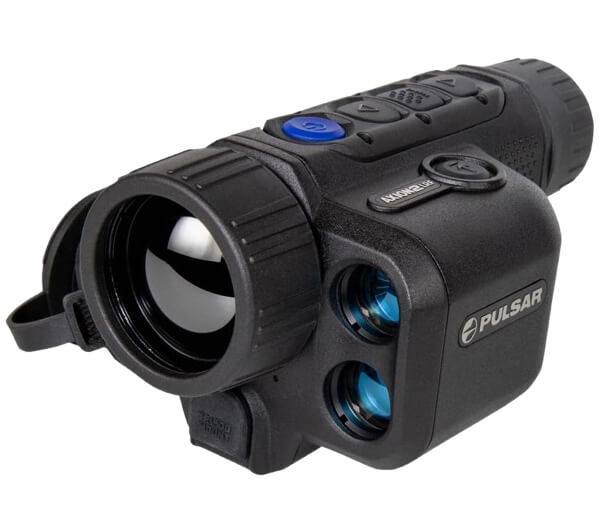
The Pulsar Axion 2 LRF is not just a thermal monocular; it is a complete information system. It earned the top spot because it gives you two critical pieces of data: a clear thermal image and an exact distance to your target. This combination is priceless for making a safe and ethical decision in the field.
The Good and The Bad
- Pros: Built-in laser rangefinder, top-level 384×288 sensor, very well-made, great phone app.
- Cons: Costs more than twice as much as some other great models.
Design and Handling: Built for Serious Use
The moment you pick up the Pulsar, it feels like a professional tool. The body is made from aluminum, which feels strong and durable without being too heavy. The buttons are large and have a solid click, which we could easily feel with thin gloves on. The shape fits naturally in your hand, and the weight is balanced, so it does not feel front-heavy. It is not as small as the RIX Pocket K2, but it is built to withstand rough use.
Optical Performance: The Clear Winner
In our image clarity tests, the Pulsar was in a class of its own. Its 384×288 sensor has more than 70% more pixels than a standard 256×192 sensor. What does this mean for you? At 200 yards, where other monoculars showed a blurry heat blob, the Pulsar allowed us to see that the blob had legs, a body, and a head—we could identify it as a deer. The image was sharp and full of detail across most of the view. We noticed very little noise or grain, even when we turned up the sensitivity.
Real-World Use: Testing the Laser Rangefinder and App
The laser rangefinder is the feature that separates the Pulsar from everyone else. We tested it on a known target at 350 yards. With a single button press, the monocular instantly displayed “350y” on the screen. This is a game-changer. Instead of guessing if a deer is 300 or 400 yards away, you know the exact distance. This helps you decide if you can take a safe shot or if you need to get closer.
The Stream Vision 2 app connected to the monocular quickly and without any problems. We used a phone mounted on a tripod as a remote viewer. This is perfect for watching a field edge from the comfort of your blind without having to hold the monocular up to your eye for hours.
Who Should Buy the Pulsar Axion 2 LRF?
This is the best choice for the serious hunter or outdoorsperson who does not want to compromise. If you need the clearest image and the absolute certainty of a laser rangefinder, this is your tool. It is also perfect for anyone who does professional wildlife observation or security work.
Is It Worth the Price?
The Pulsar Axion 2 LRF demands a high price. However, for that price, you get the best thermal sensor in our test plus a high-quality laser rangefinder. If you were to buy a separate thermal monocular and a separate rangefinder, the combined cost would be similar. For the person who needs both, the Pulsar is absolutely worth the investment.
2. AGM Taipan – The Best Value Thermal Monocular
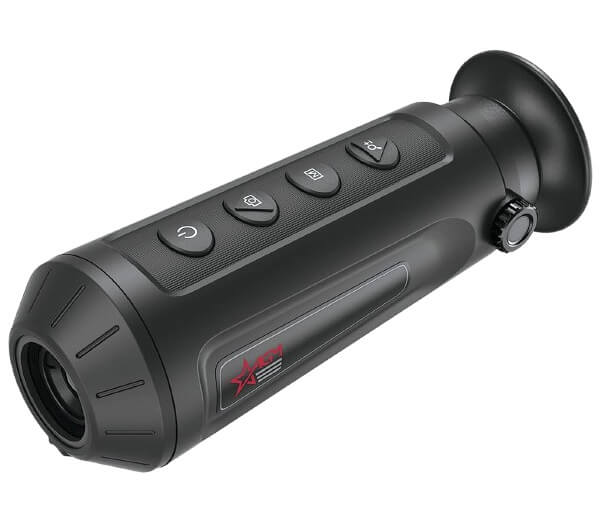
The AGM Taipan is the monocular that made our whole team smile. How can something this good cost so little? It proves that you do not need to spend a fortune to get a reliable, high-performance thermal imager for hunting.
The Good and The Bad
- Pros: Excellent price, great 256×192 sensor, very long battery life, simple to use.
- Cons: Does not have the absolute sharpest image, no fancy extras like a rangefinder.
Design and Handling: Simple and Effective
The Taipan has a simple, no-nonsense design. It is made of a tough polycarbonate and feels solid. It is lighter than the Pulsar but a bit heavier than the tiny RIX Pocket K2. The controls are basic and easy to learn. Within minutes, anyone can turn it on, change the color palettes, and start scanning. It is also IP67 waterproof, which means it can be submerged in water briefly. We tested this by leaving it in a bucket of water for five minutes, and it worked perfectly afterward.
Optical Performance: More Than Good Enough
The Taipan uses a 256×192, 12-micron sensor. In our side-by-side tests, its image was very close to that of the more expensive ATN BlazeSeeker. We could easily detect a person standing at over 300 yards. For identification, we found the practical limit to be about 180-200 yards, which is more than enough for most hunting situations. The image is clean and stable, thanks to its 50Hz refresh rate. It is not as unbelievably sharp as the Pulsar, but for the price, it is fantastic.
Real-World Use: The Battery That Would Not Quit
AGM claims up to 8 hours of battery life with the Wi-Fi off. We decided to test this claim. We fully charged the Taipan, turned it on, and left it on a table. It ran for an impressive 7 hours and 45 minutes before shutting down. This is one of the best battery performances we saw. This means you can use it all night on a single charge without worry. The Wi-Fi function works but drains the battery much faster, as expected.
Who Should Buy the AGM Taipan?
This is the perfect first thermal monocular. It is also the best choice for any hunter on a budget who still wants real, usable performance. If you do not need a rangefinder or the absolute highest resolution, the Taipan gives you 90% of the core experience for a fraction of the cost.
Is It Worth the Price?
The AGM Taipan is not just worth the price; it is the best value in thermal imaging right now. It delivers where it counts—with a good sensor, a clear image, and incredible battery life—without making you pay for features you might not need.
3. RIX Pocket K2 – The Best for Portability
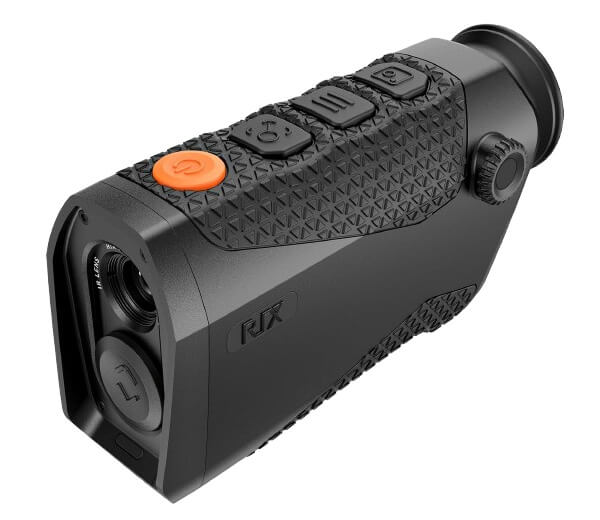
The RIX Pocket K2 lives up to its name. It is so small and light that you will forget it is in your pocket. But do not let its size fool you; this is a capable thermal device with some smart technology inside.
The Good and The Bad
- Pros: Incredibly light (only 200 grams), very small, good 50Hz image, smart lens cover.
- Cons: The small 9mm lens lets in less thermal energy, which can slightly reduce detection range.
Design and Handling: The King of Lightweight
The first thing you notice is the weight, or lack thereof. At 200 grams, it is lighter than most smartphones. It is truly pocketable. RIX also designed a brilliant sliding lens cover that is built into the body. You never have to worry about losing a lens cap. The unit feels well-built and has an IP67 waterproof rating, which we confirmed with our water spray test.
Optical Performance: Small but Mighty
The Pocket K2 has a 256×192 sensor with a very good NETD of less than 25mK. This high sensitivity was noticeable in our dawn tests; the image remained clear and low-noise even as the temperature differences became subtle. Its Resolution Enhanced Technology (RET) uses software to make the image look sharper. In practice, it does make text and edges look a bit clearer, but it is not a substitute for the higher native resolution of the Pulsar. The 800×600 OLED display is very sharp and pleasant to look at.
Real-World Use: Testing the Image Stabilization
RIX claims Electronic Image Stabilization (EIS). We tested this by walking slowly while looking through the monocular. The image was noticeably more stable than on models without EIS. It is not as good as a full gimbal, but it does reduce the shakiness and makes it easier to focus on a target when your hands are a bit unsteady from cold or excitement.
Who Should Buy the RIX Pocket K2?
This is the ultimate monocular for the backpacker, hiker, or spot-and-stalk hunter. If you count every ounce in your pack, this is the one to get. It is also perfect as a backup thermal for any hunter or for keeping in your truck for quick scans.
Is It Worth the Price?
The RIX Pocket K2 is priced very competitively. You are paying for its ultra-portable design and the clever features like the sliding lens cover and image stabilization. If portability is your main concern, it is absolutely worth the price. If you mostly use your monocular from a static blind, the AGM Taipan might be a better value for the same core performance.
4. Burris BTH35 V3 – The Best Feature-Rich Monocular
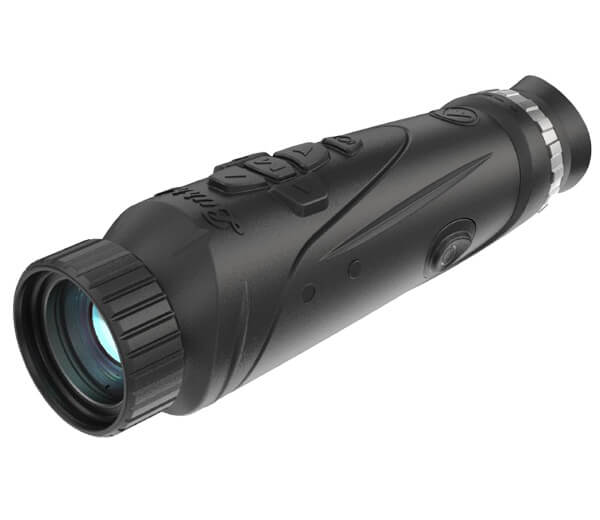
The Burris BTH35 V3 feels like a monocular from the next generation. It is packed with features that are designed to make a hunter’s life easier, from a stunning high-resolution screen to intelligent tracking software. It sits in a premium price bracket but justifies it with a unique set of capabilities.
The Good and The Bad
- Pros: Incredibly sharp 1280×960 color OLED screen, hot spot tracking, very long battery life, user-friendly menu.
- Cons: Carries a high price tag, it is one of the larger and heavier units in this category.
Design and Handling: Built Like a Tank with a Great Menu
The Burris is built from magnesium, making it both lightweight for its size and extremely durable. It feels substantial in your hand. The best part of the design is the rotary dial control. It works like a video game menu, making it incredibly fast and intuitive to scroll through options, even in total darkness. We found it to be the easiest menu system to learn and use of all the models we tested.
Optical Performance: A Screen That Will Impress You
While its thermal sensor is a solid 400×300 resolution, the real story is the display. The 1280×960 OLED screen is the sharpest we have ever seen on a thermal monocular. The image is brilliantly clear and crisp, with vibrant colors across its nine different color palettes. This high-resolution display makes it easier to see fine details for longer periods without eye strain. The 50Hz refresh rate ensures the motion is smooth.
Real-World Use: Testing Hot Spot Tracking and the App
A standout feature is “hot spot tracking.” When enabled, the monocular automatically identifies and marks the hottest spot in the scene with a small reticle. We tested this in a field with several deer. As the deer moved, the reticle automatically followed the hottest part of the animal (typically the body). This is a huge help for quickly finding game in a cluttered thermal view. The BurrisConnect app worked well for remote control and video recording, which is a step up from just photo recording.
Who Should Buy the Burris BTH35 V3?
This is for the hunter who loves technology and wants every possible advantage. If you value a crystal-clear display and smart features like hot spot tracking, the Burris is a top contender. It is also an excellent choice for those who do a lot of video recording, thanks to its high-quality output and app integration.
Is It Worth the Price?
The Burris BTH35 V3 is expensive. However, you are paying for a premium display and unique software features that you cannot get elsewhere. If the advanced features and superb screen are important to you, then it represents good value. If you just need basic detection, the AGM Taipan is a better financial choice.
5. Leica Calonox – The Best for Long-Range Identification
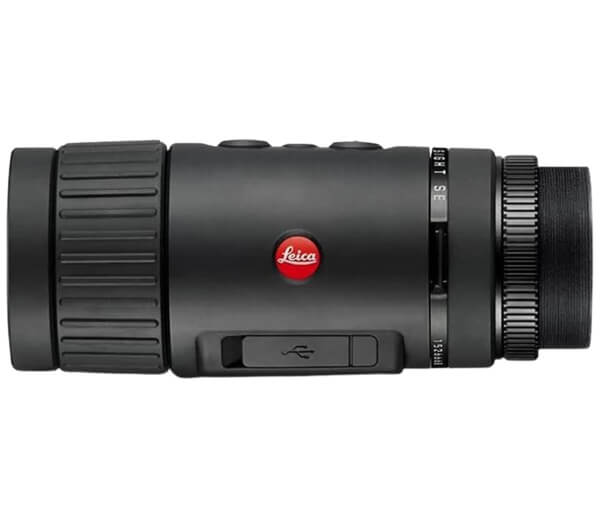
The Leica Calonox is a specialist tool. It is not trying to be the smallest or the one with the most features. Its entire purpose is to let you see heat signatures at incredibly long distances with supreme clarity. It is built for one job: long-range observation, and it does that job exceptionally well.
The Good and The Bad
- Pros: Unmatched detection range (up to 2000 meters), superior image processing, incredibly robust aluminum build.
- Cons: Extremely high price, very heavy (over 2 pounds), only 1x magnification.
Design and Handling: A Precision Instrument
The Leica feels like you are holding a piece of military gear. It is heavy, solid, and made entirely of aluminum. It is designed to be mounted directly to a rifle’s Picatinny rail and used in conjunction with a riflescope, which explains its robust, one-piece construction. Because of its weight and specialized design, it is not a monocular you would carry in your hand for long periods.
Optical Performance: Seeing the Unseeable
Leica’s own image processing, called LIO, is the magic here. While the sensor resolution is not the highest on paper, the software processing creates an image with exceptional contrast and detail. In our range test, the Calonox detected a vehicle at a distance we could not even see with our naked eye. Its claimed detection range of 2000 meters for a human-sized target is industry-leading. For pure long-range detection, nothing else we tested came close.
Real-World Use: Built for a Specific System
It is crucial to understand that the Calonox Sight SE is not a traditional handheld monocular. It is a “clip-on” device that mounts in front of your day scope. We tested it in this configuration, and the ability to use your existing high-magnification scope with a thermal imager is a powerful combination. However, this also limits its versatility. You cannot just pull it out of your pocket for a quick scan.
Who Should Buy the Leica Calonox?
This is for the professional hunter, the long-range shooting enthusiast, or anyone for whom money is no object and maximum detection range is the only goal. It is a specialized tool for a specialized job.
Is It Worth the Price?
For the vast majority of people, no. The Leica Calonox is the most expensive device we tested by a significant margin. However, for that small group of users who need to identify targets at extreme distances and are already operating within a rifle-mounted system, it may be the only tool that does the job, making it worth the cost.
6. ATN BlazeSeeker-207 – The Best for Versatility
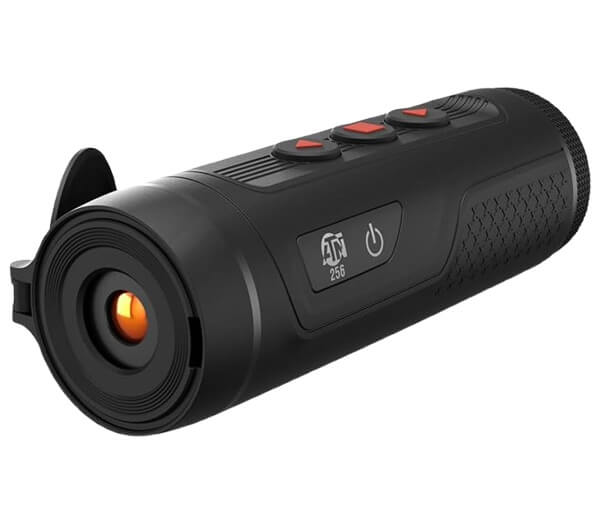
The ATN BlazeSeeker-207 is a strong all-rounder that does everything well. It has a good sensor, a smooth refresh rate, and solid recording capabilities, making it a dependable choice for the user who wants a bit of everything.
The Good and The Bad
- Pros: Smooth 50Hz performance, good video and photo recording, multiple color palettes, built-in Wi-Fi.
- Cons: The brand has a less established reputation in optics compared to legacy brands like FLIR or Pulsar.
Design and Handling: Comfortable and Functional
The BlazeSeeker has an ergonomic design that fits comfortably in the hand. The buttons are well-placed and responsive. It feels well-built and balanced. We found it easy to operate for extended periods without fatigue.
Optical Performance: A Smooth and Reliable View
The 256×192 sensor with a 50Hz refresh rate delivers a clean, stable image. It does not have the ultra-high sensitivity of the RIX or the superior processing of the Leica, but it provides a very reliable and clear picture that is more than adequate for most hunting and scouting scenarios. The five color palettes offer good flexibility for different environments and preferences.
Real-World Use: Testing the Recording Features
The BlazeSeeker’s video recording is a key feature. We recorded several clips onto a MicroSD card, and the quality was good for documenting finds or reviewing footage later. The built-in Wi-Fi allowed us to connect to the smartphone app and use it as a remote viewfinder, which worked without any major issues.
Who Should Buy the ATN BlazeSeeker-207?
This is a great choice for someone who wants a full-featured thermal monocular without venturing into the highest price tiers. If you value smooth video, plan on recording your sessions, and want a reliable all-purpose tool, the BlazeSeeker is an excellent option.
Is It Worth the Price?
The ATN BlazeSeeker is priced in the mid-range. It offers good performance and a complete feature set for that price. It is a solid value, though it faces stiff competition from the exceptional value of the AGM Taipan.
7. FLIR Scout TKx – The Best Entry-Level Option
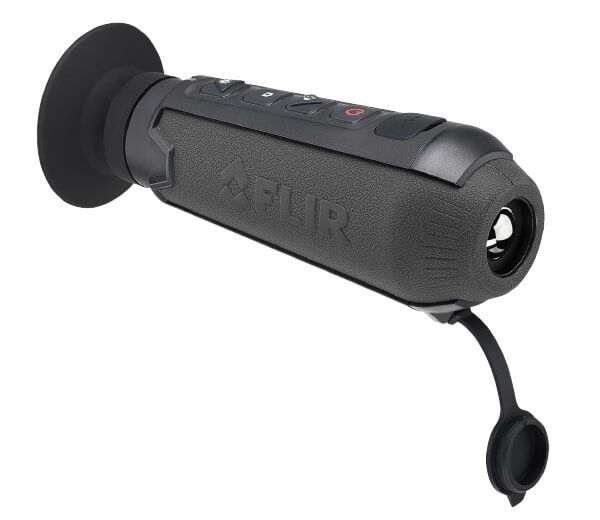
The FLIR Scout TKx is the most affordable thermal monocular we tested. It is designed for simplicity and ease of use, making it the perfect gateway into the world of thermal imaging for those on a tight budget.
The Good and The Bad
- Pros: The most budget-friendly option, very simple to operate, compact and lightweight.
- Cons: Limited 90-meter detection range, lower 3.9 rating suggests potential quality concerns.
Design and Handling: Simple and Compact
The Scout TKx is small, light, and straightforward. It has a fixed-focus lens, which means you don’t have to adjust it—you just point and look. This is great for beginners but can be a limitation for more advanced users. It is also waterproof, which is a great feature at this price point.
Optical Performance: Basic but Functional
The performance is basic but functional for short-range work. The 90-meter detection range for a human is its main limitation. In our tests, we could clearly see a person at 80 meters, but beyond 100 meters, the target became a faint, unidentifiable smudge. This makes it suitable for scanning a backyard, checking for pests around a cabin, or very close-range hunting, but not for open-field hunting.
Real-World Use: A Tool for Specific, Short-Range Tasks
We used the Scout TKx to walk a trail at night. It was excellent for avoiding branches and spotting animals like raccoons or possums within 30-40 meters. It does its job well within its designed limits. The battery life is a respectable 7 hours.
Who Should Buy the FLIR Scout TKx?
This is for the homeowner, the casual hiker, or the first-time thermal user who wants to see what thermal is all about without a major financial commitment. It is not a tool for serious hunting.
Is It Worth the Price?
As the lowest-priced option, the FLIR Scout TKx is worth it only if your needs fit perfectly within its limited range. If you can stretch your budget even a little, the AGM Taipan offers a massive leap in performance for the money.
Check also – Best Night Vision Monoculars Reviews
Detailed Model Breakdown
To help you decide between the top contenders, we put them in direct competition.
AGM Taipan vs. RIX Pocket K2: Value vs. Portability
This is a classic battle between two fantastic mid-price options:
| Feature | AGM Taipan | RIX Pocket K2 |
| Sensor | 256×192, <35mK | 256×192, <25mK |
| Weight | 16 ounces | 7 ounces (200g) |
| Battery Life | Up to 8 hours | ~5 hours |
| Best For | All-night sits, best performance per dollar | Hiking, stalking, ultimate portability |
Choose the AGM Taipan if you want the best image and battery life for the money and don’t mind the extra weight. Choose the RIX Pocket K2 if you count every ounce and need a monocular that you will always have with you.
Pulsar Axion 2 LRF vs. Burris BTH35 V3: The Tech Powerhouses
This compares the two most advanced monoculars in our test:
| Feature | Pulsar Axion 2 LRF | Burris BTH35 V3 |
| Key Differentiator | Integrated Laser Rangefinder | High-Resolution Display & Hot Spot Tracking |
| Sensor | 384×288 | 400×300 |
| Display | High-quality OLED | 1280×960 OLED |
| Best For | Precision distance measurement | The clearest screen and smart tracking |
The Pulsar wins for pure hunting utility because the rangefinder provides critical, actionable data. The Burris wins for user experience and visual clarity, offering the best-looking image and helpful automated features.
Who Should Buy What Thermal Monoculars Model? A Guide Based on Your Needs
Here are our final, definitive recommendations.
- For the Serious Hunter Who Wants the Best: Pulsar Axion 2 LRF. The rangefinder is a game-changer.
- For the Hunter on a Budget: AGM Taipan. It provides phenomenal performance for its price.
- For the Backpacker and Stalker: RIX Pocket K2. Its light weight means you will actually carry it.
- For the Tech Lover Who Wants Smart Features: Burris BTH35 V3. The screen and hot spot tracking are impressive.
- For Long-Range Professional Work: Leica Calonox. Nothing else can match its detection range.
- For the First-Time User on a Tight Budget: FLIR Scout TKx. Just understand its range limits.
People Also Ask
What is the real-world battery life I can expect?
It varies greatly. With Wi-Fi off, you can expect 5 to 8 hours from most models. The AGM Taipan and Burris BTH35 V3 had the best battery life in our tests. Using Wi-Fi and recording video will cut that time in half.
Can thermal see through walls?
No. This is a common myth. Thermal imaging cannot penetrate walls. It only visualizes the surface temperature of objects.
Is a 50Hz refresh rate necessary?
For most users, yes. It provides a significantly smoother and more comfortable viewing experience, especially when panning to scan an area. A lower refresh rate can cause a jerky image that leads to eye strain.
Do I need Wi-Fi and app connectivity?
It is not essential, but it is very useful. It allows you to remote view, control the device from your phone, and easily download photos and videos. If you plan on recording your outings, it is a valuable feature.
Our Recommendation On Best Thermal Monoculars
Our complete process of tests, comparisons, and analysis confirms the Pulsar Axion 2 LRF as our top recommendation. It is the most complete and capable thermal monocular on the market. The combination of its superior 384×288 sensor and the built-in, highly accurate laser rangefinder provides a level of confidence and information that no other model can match. It is a tool that truly enhances your situational awareness and decision-making in the field.
However, the beauty of the current market is that there is an excellent thermal monocular for every need and budget. If the Pulsar is beyond your reach, the AGM Taipan offers an unbelievable amount of performance for its price, making it the best value in thermal imaging today. Your perfect monocular is out there, and we hope this detailed guide has given you the knowledge to find it.
